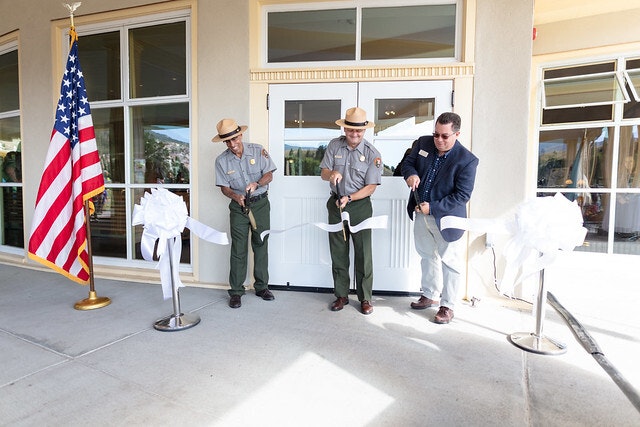After a year of remodeling and reconstruction, the historic Mammoth Hot Springs Hotel in Yellowstone National Park has been restored to its original grandeur, befitting the structure’s status as the primary lodging at the headquarters of America’s first national park.

At a ribbon-cutting Friday at Mammoth Hot Springs, visitors and dignitaries got a first look at the $30 million restoration, which Rick Hoeninghausen, sales and marketing director for Xanterra Travel Collection in Yellowstone, said brought the original “shine” back to the hotel.
Yellowstone and Xanterra partnered to preserve the historic look and feel of this important “art moderne” structure, one of the few of that type in the national park system.



NPS / Jacob W. Frank
At the time of its construction in 1883, Mammoth (then called the “National Hotel”) was one of the “big four” lodges in Yellowstone, along with the Lake Hotel, the Old Faithful Inn, and Canyon Hotel.
Since its opening, the hotel has undergone several major structural changes. According to the Yellowstone Insider website, the fourth floor of the original hotel was removed in 1913 and a north wing was added. That north wing was the only portion of the hotel to survive a major renovation in 1936 and several cabins were added to the complex in 1938.
Hoeninghausen said the most recent renovation was originally set to be a Park Service project, as they own the building, but Xanterra partnered with the Park Service to take the walls down to the studs and start from the basics.

NPS / Jacob W. Frank 
NPS / Jacob W. Frank 
NPS / Jacob W. Frank 
NPS / Jacob W. Frank 
NPS / Jacob W. Frank
“There was a shared bathroom on every hall, and there’s four floors, so about a third of the rooms in the hotel were without bathrooms,” said Hoeninghausen.
Now, all the rooms have private baths, but that meant the hotel had to reduce the number of rooms from 97 to 79.
Hoeninghausen said in more than 75 years, there have been updates to carpeting, bedding, etc., but no major renovations.
“In the old wing, you’d walk down the hallway and wires would be exposed, plumbing would be exposed – not dangerously, but you could see them running along where the ceiling meets the walls,” he said.
A major emphasis of the newest renovation has been on sustainability and longevity, according to Hoeninghausen – this includes focusing on accessibility and reducing the building’s carbon footprint, as well as taking into account the geology of Yellowstone.
“Whenever we or the Park Service go into the major renovation of a building, one of the first things we look at is the foundation from a standpoint of seismic stability and meeting the current seismic codes,” said Hoeninghausen.
He added that because Yellowstone sits on top of a “supervolcano”, meeting seismic standards was important.

NPS / Jacob W. Frank 
NPS / Jacob W. Frank
Another update to the Mammoth Hot Springs hotel this year was the rehabilitation of the famous wooden map in the Map Room. The map was designed by Robert Reamer in the 1930s – it contains more than 2500 pieces, and is made from 15 different types of wood. Reamer is perhaps best known for being the architect of the Old Faithful Inn, and also contributed to the current style of the Mammoth Hot Springs Hotel.
“The fact that it’s been so long since it’s been updated, that’s where some that ‘shine’ had left,” Hoeninghausen added. “Now we have a hotel that’s historic, but in many ways it’s new, and it will preserve that historic building for many, many more generations. The Park deserves this.”
The Mammoth Hot Springs Hotel operates year-round, as the north entrance to the Park is the only gateway that remains open throughout the winter. Hoeninghausen said that because the hotel is at Mammoth, where Park Headquarters is located, a lot of VIP travelers come through, as well as the guests interested in wildlife watching and exploring the unique geographic features of the northern part of Yellowstone.





